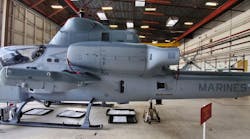A team of engineers and scientist at the U.S. Naval Research Laboratory’s Center for Corrosion Science and Engineering developed a safer and user-friendly topcoat that was recently applied onto the exterior of Navy and Marine Corps aircraft. Fighting corrosion is an ongoing battle for Navy and Marine aircraft as they routinely operate over salty, corrosive ocean environments
The topcoat is a one-component (1K) polysiloxane based on organosilane polymers that is free of harmful isocyanates and other hazardous air polluting (HAP) chemicals. Isocyanates and HAPs are found in two-component (2K) polyurethane topcoats currently used on Department of Defense (DoD) and commercial aircraft.
Erick Iezzi, Ph.D., senior research chemist at NRL, along with engineers at Naval Air Warfare Center – Aircraft Division, applied the new topcoat onto a U.S. Navy F/A-18 Hornet located at Naval Air Station Patuxent River, Md. Additionally, the 1K topcoat was applied on Marine Corps UH-1Y Venom and AH-1Z Viper helicopters located at Marine Corps Air Station New River, Jacksonville, N.C. and Marine Corps Base Camp Pendleton, Calif., respectively.
The 1K polysiloxane topcoat was put on a Navy F/A-18 Hornet and two Marine helicopters—a UN01Y Venom and an AH-1Z Viper—for a one- to two-year evaluation period.
Polyurethane topcoats have existed for several decades, yet within a few years the Navy has been able develop an environmentally friendly alterative that provides similar laboratory performance and is easy for painters to use.
According to the Occupational Safety and Health Administration (OSHA), exposure to isocyanates can irritate the skin and mucous membranes, and cause chest tightness and difficulty breathing. They are classified as potential human carcinogens. Isocyanate exposure can also cause sensitization, resulting in severe asthma attacks by subsequent exposures at even low levels.
Replacing isocyanates with polysiloxane provides a safer coating for painters and anyone conducting maintenance in nearby areas. The new 1K topcoat also contains lower levels of volatile organic compounds, which hurt air quality when released during spray applications.
The 1K polysiloxane topcoat requires no metering or mixing of components because all chemicals are in a single container, thereby reducing prep time and providing a more consistent color on aircraft. The container is also resealable for future use, which means lower levels of hazardous waste and disposal costs.
The NRL team had previously developed coatings for surface ships, but requirements for aircraft coatings are more demanding. Aircraft have aluminum skin, which means the coating must provide greater flexibility, especially at cold temperatures during high-altitude flight. And the topcoat on aircraft must retain a camouflage appearance for longer periods of time.
As part of NRL’s large patent portfolio, the polymers and polysiloxane coatings are covered by U.S. patents 9139753, 9701868, and 10190020. The first two patents are partially licensed by NCP Coatings, which makes the camouflage topcoat for demonstrations and field validation. NCP Coatings also uses the technology to develop semi- and high-gloss formulations for aircraft.

